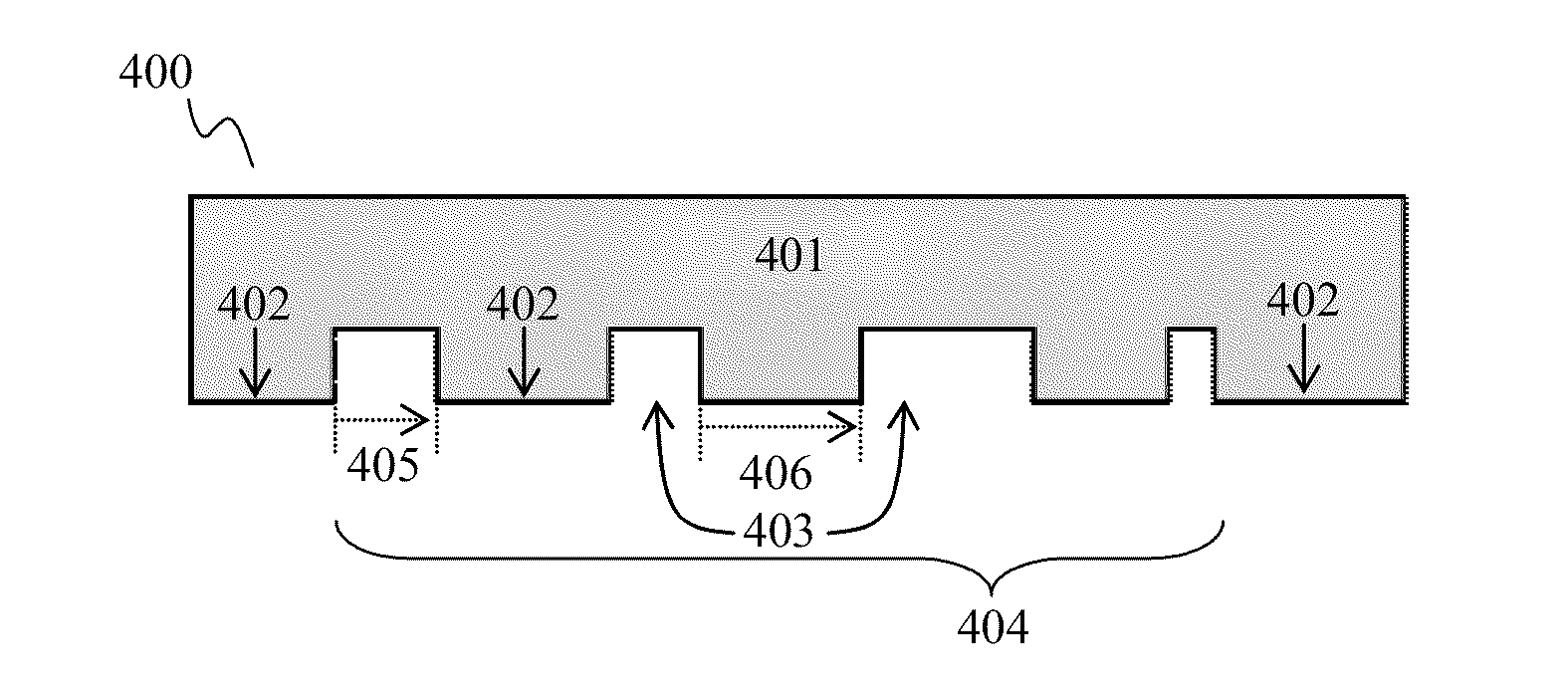Methods of Patterning Substrates Using Microcontact Printed Polymer Resists and Articles Prepared Therefrom
a technology of printed polymer resist and patterning substrate, which is applied in the field of method of patterning substrate, can solve the problems of difficult and/or costly patterning on very large and/or non-rigid surfaces such as textiles, paper, plastics, etc., and achieve the effects of cost-effective, efficient and reproducibl
- Summary
- Abstract
- Description
- Claims
- Application Information
AI Technical Summary
Benefits of technology
Problems solved by technology
Method used
Image
Examples
example 1
[0212]A 200 mm by 200 mm square-shaped stamp comprising a flexible material (polydimethylsiloxane, “PDMS”) having a desired topography was prepared from a master using methods previously described elsewhere. See, e.g., U.S. Pat. Nos. 5,512,131 and 5,900,160, which are incorporated herein by reference in their entirety. The stamp was spin-coated with a thin layer of a resist composition comprising a thermoelastic polymer (styrene-(ethylene-butylene) triblock copolymer grafted with maleic anhydride, “SEBMA”) in a solvent (toluene), 1.5% SEBMA, by weight. The thermoelastic polymer-coated stamp was then contacted for 60 seconds with a composite substrate of a 270 nm thick indium-tin-oxide (“ITO”) layer coated on a glass support. The temperature of the substrate was maintained at 130° C. during the contacting. The stamp was then removed from the substrate, and the substrate was annealed approximately 60 s at 130° C. The resulting thermoelastic polymer pattern on the substrate had a thick...
example 2
[0220]The patterned substrates prepared in Example 1 were quantitatively analyzed to determine the type and number of defects as well as the average feature size of the patterns formed. The results are summarized in Table 1. The top-lateral dimension (“TLD”) refers to the lateral dimension of the subtractive non-penetrating features as measured on the surface of the substrate (i.e., lateral dimension 165 in FIG. 1G). The first lateral dimension measured at the base of the feature (“BLD1”) refers to the lateral dimension of the subtractive non-penetrating feature at the base of the feature (i.e., lateral dimension 169 in FIG. 1G). The difference between these lateral dimension, Δ, is related to the sidewall angle. The features had a height of 270 nm.
TABLE 1Defect rate and lateral dimensions of subtractivenon-penetrating features formed in a composite substrate(ITO on glass), as described in Example 1.Avg. Per100 FeaturesSample 1Sample 2Sample 3AverageBridging0000DefectsPairing0000Def...
example 3
[0222]The patterning method described in Example 1 was used to pattern a 200 mm×200 mm square glass substrate having a 270 nm ITO coating thereon. The resulting pattern of ITO islands surrounded by subtractive non-penetrating features is shown in FIG. 15. Referring to FIG. 15, a top-view microscope image, 1500, of a patterned substrate from which a portion of an ITO coating has been removed is provided. The patterned substrate includes areas comprising rectilinear-shaped ITO islands, 1501, as well as triangular shaped ITO-islands, 1502, on a glass substrate.
PUM
| Property | Measurement | Unit |
|---|---|---|
| Young's Modulus | aaaaa | aaaaa |
| molecular weight | aaaaa | aaaaa |
| boiling point | aaaaa | aaaaa |
Abstract
Description
Claims
Application Information
 Login to View More
Login to View More - R&D
- Intellectual Property
- Life Sciences
- Materials
- Tech Scout
- Unparalleled Data Quality
- Higher Quality Content
- 60% Fewer Hallucinations
Browse by: Latest US Patents, China's latest patents, Technical Efficacy Thesaurus, Application Domain, Technology Topic, Popular Technical Reports.
© 2025 PatSnap. All rights reserved.Legal|Privacy policy|Modern Slavery Act Transparency Statement|Sitemap|About US| Contact US: help@patsnap.com



